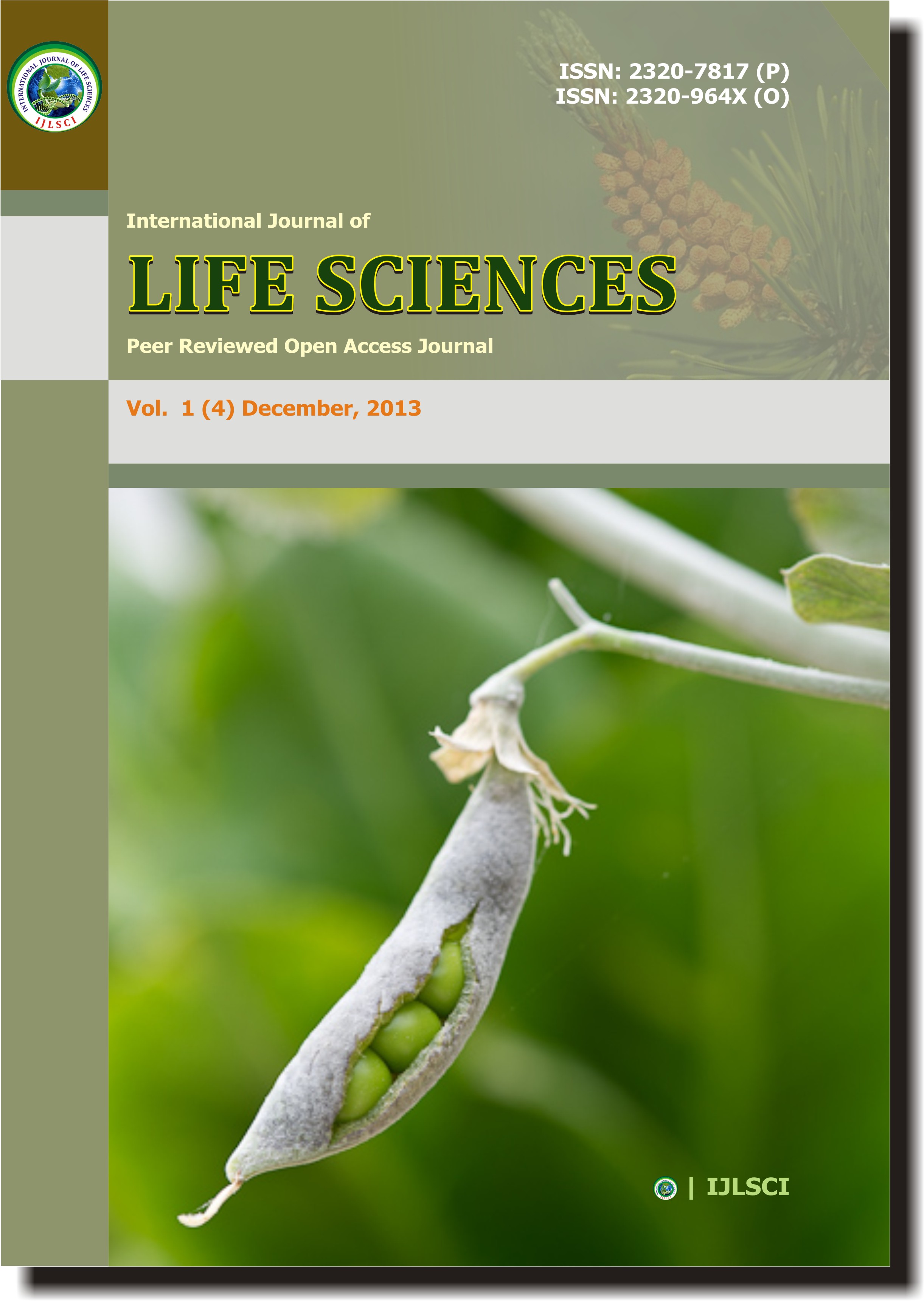Isolation and Screening of Cellulose Degrading Microbes from Nagpur Region Soil
Keywords:
Cellulose Degradation, Bacteria, Fungi, SoilAbstract
Cellulose is world’s most abundant organic substance and comprises a major storage form of glucose. Microbial cellulose utilization is responsible for one of the largest material flow in the biosphere therefore the aim of the study is to isolate cellulose degrading microbes from soil samples collected from different regions and to identify cellulose degrading microbes including bacteria and fungi. Two different types of cellulose-degrading bacteria and two types of cellulose degrading fungi were isolated from six different soil samples for cellulose degradation. A total of two isolates each of Thermoactinomycetes spp. and Pseudomonas spp. were isolated as well as two isolates of Aspergillus spp. and one isolate of Penicillium spp. were also isolated. Clear zone around the colony was the indication of the cellulose degradation activity of the microorganisms.
Downloads
References
Andro T, Chambost JP, Kotoujansky A, Cattano J, Barras F (1984) Mutants of Erwinia chrysanthemi defective in secretion of pectinase and cellulase. J Bacteriol., 160:1199-1203.
Bagnara C, Toci R, Gaudin C, Bélaïch JP (1985) Isolation and characterization of a cellulolytic microorganism, Cellulomonas fermentans, sp. nov. Int. J. Syst. Bacteriol., 35:502-507.
Chakraborty N, Sarkar GM, Lahiri SC (2000) Cellulose degrading capabilities of cellulolytic bacteria isolated from the intestinal fluids of the silver cricket. Environmentalist, 20(1): 9–11.
Chen HJ, Chang HJ, Fan C, Chen WH, Lee MS (2011) Screening, isolation and characterization of cellulose biotransformation bacteria from specific soils. International Conference on Environment and Industrial Innovation, 12: 216-220.
Cowan ST, Steel KJ (1993) Manual for the identification of medical bacteria 3rd edn. Cambridge University press, USA, pp: 150-152.
Cullimore DR (2000) Practical Atlas for Bacterial Identification. Lewis Publishers, Boca Raton, London, New York, pp: 209.
Ekperigin MM (2007) Preliminary studies of cellulase production by Acinetobacter anitratus and Branhamella spp. African Journal of Biotechnology, 6(1): 28–33.
Ghanbary MAT, Lotfi A, Asgharzadeh A, Telmadarrehei T, Javadi MA (2010) Laboratory simulation of cellulomonas degradation by soil Aspergillus. American Eurasian J. Agric. & Environ. Sci., 7(2): 146-148.
Gupta P, Samant K, Sahu A (2012) Isolation of cellulose-degrading bacteria and determination of
Kadarmoidheen M, Saranraj P, Stella D (2012) Effect of cellulolytic fungi on the degradation of cellulosic agricultural wastes. International Journal of Applied Microbiology Science, 1(2): 13-23.
Klich MA (2002) Identification of common Aspergillus species. CBS Netherlands, pp: 116.
Lu WJ, Wang HT, Nie YF (2004) Effect of inoculating flower stalks and vegetable waste with ligno-cellulolytic microorganisms on the composting process. Journal of Environmental Science and Health, Part B, 39(5-6): 871–887.
Mandels M, Weber J (1969) Production of cellulases. Adv. Chem. Ser., 95: 391- 414.
McDonald JE, Rooks DJ, McCarthy AJ (2012) Methods for the isolation of cellulose-degrading microorganisms. Methods Enzymol., 510: 349-374.
Milala MA, Shugaba A, Gidado A, Ene AC, Wafar JA (2005) Studies on the use of agricultural wastes for cellulase enzyme production by A. niger. Journal of Agriculture and Biological Science, 1: 325–328.
Mswaka AY, Magan N (1998) Wood degradation and cellulase and ligninase production, by Trametes and other wood-inhabiting basidiomycetes from indigenous forests of Zimbabwe. Mycological Research, 102(11): 1399–1404.
Nutt A, Sild V, Prtterson G, Johansson G (1998) Progress curve as a means for functional classification of cellulases. Europian Journal of Biochemistry, 258:200.
Ryu DDY, Mandels M (1980) Cellulases: biosynthesis and applications. Enzyme and Microbial Technology, 2(2):91–102.
Samdhu DK and Bawa S (1992) Improvement of cellulase activity in Trichoderma. Applied Biochemistry and Biotechnology, 34-35(1):175–192.
Schwarz WH (2001) The cellulosome and cellulose degradation by anaerobic bacteria. Applied Microbiology and Biotechnology, 56(5-6): 634–649.
Shewale JG (1982) Glucosidase: its role in cellulase synthesis and hydrolysis of cellulose. International Journal of Biochemistry, 14(6):435–443.
Vaithanomsat P, Chuichulcherm S, Apiwatanapiwat W (2009) Bioethanol production from enzymatically saccharified sunflower stalks using steam explosion as pretreatment. Proceedings of World Academy of Science, Engineering and Technology, 37: 140–143.
Wood TM (1989) Synergism between enzyme components of Penicillium pinophilum cellulase in solubilizing hydrogen ordered cellulose. Journal of Biochemistry, 260: 37–43.
Woodward and Wiseman A (1983) Fungal and other β-d-glucosidases: their properties and applications. Enzyme and Microbial Technology, 4(2): 73–79.
Yin LJ, Huang PS, Lin HH (2010) Isolation of cellulase-producing bacteria and characterization of the cellulase from the isolated bacterium Cellulomonas spp. YJ5. J Agric Food Chem, 58:9833–9837.
Tendulkar SR,, Saikumari YK, Patel V, Raghotama S, Balaram P and Chattoo BB. (2007) Isolation, purification and characterization of an antifungalmolecule produced by Bacillus licheniformis BC98, and its effect on phytopathogen Magnaporthe grisea. Journal of Applied Microbiology, 103:2331–2339.
Downloads
Published
How to Cite
Issue
Section
License
Copyright (c) 2013 Authors

This work is licensed under a Creative Commons Attribution-NonCommercial-NoDerivatives 4.0 International License.
Open Access This article is licensed under a Creative Commons Attribution 4.0 International License, which permits use, sharing, adaptation, distribution and reproduction in any medium or format, as long as you give appropriate credit to the original author(s) and the source, provide a link to the Creative Commons license, and indicate if changes were made. The images or other third party material in this article are included in the article’s Creative Commons license unless indicated otherwise in a credit line to the material. If the material is not included in the article’s Creative Commons license and your intended use is not permitted by statutory regulation or exceeds the permitted use, you will need to obtain permission directly from the copyright holder. To view a copy of this license, visit http://creativecommons.org/ licenses/by/4.0/











